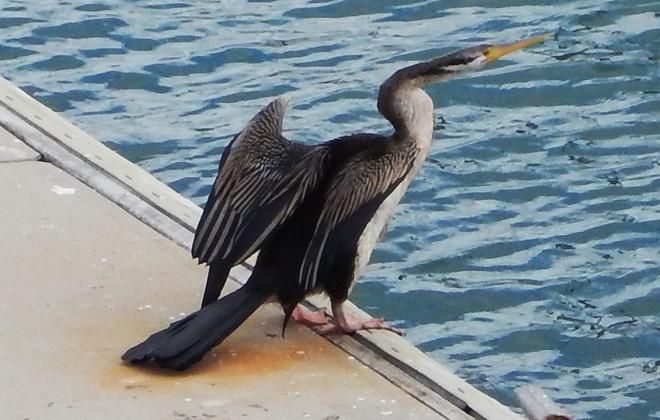Published in the Ocean Watch column, Honolulu Star-Advertiser © Susan Scott
June 29, 2015
Burnett River, Australia » It’s all well and good to have a sailboat in Australia and talk about sailing the Great Barrier Reef. It’s another thing to actually do it.
As with most outdoor adventures, weather is everything. Like our own northeast tradewinds, the southeast tradewinds here can blow your socks off, which is currently the case. A voyage to the closest atoll, Lady Musgrave, in this weather would feel like a trip from Oahu to Kauai in gusty trades and high seas. Not fun. We’re waiting.
 Australian darters are also known as snakebirds, anhingas and water turkeys.
Australian darters are also known as snakebirds, anhingas and water turkeys.
©2015 Susan Scott
But no worries. Our sailboat, Honu, is at the mouth of the Burnett River, a nutrient-rich body of water where fresh and salt water meet. The conditions outside the estuary might be frightful, but in here it’s calm and there’s enough wildlife to keep me entertained for weeks. Besides white pelicans, blue soldier crabs, pink parrots and frisky dolphins, we’re surrounded by snakes.
Well, they look like snakes at first glance. In fact, they’re birds known as snakebirds or Australian darters. On the southeast coast of the U.S., people call them anhingas.
Darters paddle their bodies smoothly underwater between the rows of boats in the marina, holding their narrow heads and S-shaped necks above the surface looking for all the world like fast snakes. In a flash the “snake” disappears, leaving only the V of its wake.
The birds aren’t chasing prey. When they’re on the move they’re stalking it, and when they dive, they’re stabbing it.
Because darters’ feathers aren’t waterproof, they get soaked and heavy, handy for sinking beneath the surface. The bird propels its body with its feet, slipping silently and smoothly along, head up, until it spots something to eat. The darters’ favorite is fish, but they also eat invertebrates and river turtles.
The bird impales its food with a sharp, daggerlike beak. This is possible because the darter has a hingelike mechanism in its long neck that enables the bird to snap neck, head and pointy bill forward as if throwing a spear.
Darters can stay underwater for only a minute or so, so it’s worth waiting around to see their next trick. With a toss of the head, the bird throws its catch in the air and swallows it head-first in one gulp.
After dinner the darter jumps to a safe place, in this case a pier, and, like its cormorant cousins, hangs its wings out to dry.
I was surprised to see that darter bodies are plump, because in the water they look sleek as snakes.
If I get tired of estuary animals, I can always walk to the beach park and watch kangaroos. I may not be on the GBR, but I’m inside it, and that’s just as good.